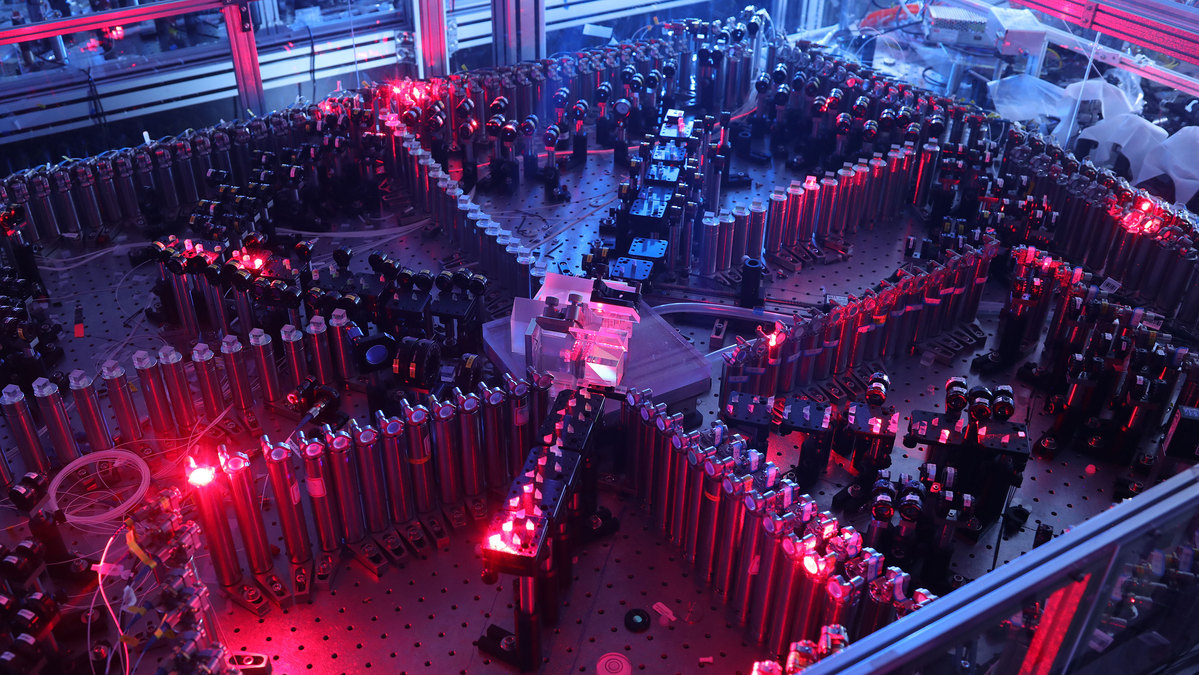
A section of the light-based quantum computer created by researchers at the University of Science and Technology of China. [Photo/Xinhua]
Chinese physicists have created a large-scale, ordered and tunable lattice of Majorana zero mode, one of the most exotic phenomena in condensed matter physics-the study of the physical properties of matter, according to a study published in the journal Nature on Wednesday.
Experts said the study may pave the way for more reliable and fault-tolerant quantum computers that can facilitate discoveries in medicine, chemistry, materials science and other fields. However, designing a quantum computer using Majorana zero mode is still in its infancy, and its feasibility and practicality may take decades of research to mature, they added.
In 1937, renowned Italian physicist Ettore Majorana hypothesized that there is a particle, later called Majorana fermion, that can be both an elementary particle and its own antiparticle at the same time. Typically, when a particle and its antiparticle collide, they would destroy each other and release a large amount of energy, but Majorana fermion is an exception to this rule.
After more than eight decades, scientists have yet to find the Majorana particle in the universe.
However, researchers of condensed matter physics have discovered that the analogy of Majorana fermion can exist to some extent in superconductors in the form of Majorana zero mode.
Gao Hongjun, vice-president of the Chinese Academy of Sciences, said Majorana zero mode has been an exciting and rapidly developing field in condensed matter physics given its potential to revolutionize quantum computation.
For instance, one of the biggest engineering challenges of quantum computers is decoherence-external disturbances that interfere with the delicate quantum states of qubits, leading to the creation and accumulation of errors. A qubit is the basic unit of information in quantum computers for storage and calculation, similar to the ones and zeros used in standard computers.
Fang Zhong, the director of the Institute of Physics at the CAS, said the current solution to quantum decoherence is to use a large number of qubits as a buffer to calibrate the ones that do calculations. But manipulating large numbers of qubits is notoriously difficult, which severely limits the practicality and scalability of quantum computers, he said.
An intriguing part of Majorana zero modes is that they are inherently resilient to decoherence and have a significantly lower error rate compared to qubits created using other methods thanks to a unique property called topological protection.
Therefore, if scientists can create logical qubits using Majorana zero modes, they can theoretically make fault-tolerant topological quantum computers that are more efficient and practical, Fang said.
Microsoft's Azure Quantum program is hoping to build a prototype of this type of quantum machine. However, many experts have noted that the process is still in its early theoretical phase, and the effort is considered "a high risk, high reward" endeavor.
Milestone study
Gao called the Chinese study a milestone as it essentially laid the first solid step toward a topological quantum computer.
By placing a superconductor made of iron, lithium and arsenic in magnetic fields and at a temperature close to-273.15 C, or absolute zero, Chinese physicists discovered that they could create an ordered lattice of Majorana zero mode on the sample material.
Su Gang, the director of the Bureau of Frontier Sciences and Education at the CAS, said just a few years ago, it would have taken enormous effort just to create a single Majorana zero mode. Now, scientists can make rows of it, allowing them to study the interactions of these elusive physical phenomena.
For example, by increasing the strength of the magnetic fields, scientists discovered that the number of Majorana zero modes within a certain area can actually increase.
"The significance of the study is that for the first time, we have achieved a large-scale, highly ordered and tunable lattice of Majorana zero mode, which has laid a solid foundation for topological quantum computers," he said.
Quantum computing is widely regarded as one of the most disruptive technologies in the world given its ability to harness the laws of quantum mechanics and solve calculations too complex for even the most powerful conventional supercomputers, such as modeling chemical reactions and optimizing financial decisions.
According to a 2021 report by global consulting firm McKinsey&Company, quantum computing will have a conservative estimated value of up to $700 billion by 2035 for industries such as pharmaceuticals, chemicals, automotive and finance. However, quantum machines won't replace ordinary computers because people's everyday software doesn't require such computing power.